
Tokyo is one of the first stops for many overseas visitors when visiting Japan. In addition to the city's many attractive and trendy modern restaurants, there is also a great deal of old Tokyo restaurants that have kept their doors open for over a century.
These places not only reveal much about the past of Japanese food culture, but they also offer the opportunity to taste classic recipes - many of which have remained relatively unchanged over the many years.
These five old Tokyo restaurants can be found in the city's old districts, like the Nihonbashi and Ginza areas, once-bustling commercial streets near Edo Castle.
Despite their tasty legacy, these shops are nevertheless quite affordable too! So follow us as we walk to these famous old shops together and meet old Tokyo while eating a piece of history!
- Table of Contents
-
- 1. Nihonbashi Iseju (Est. 1869): An Old Tokyo Restaurant Serving Up Wagyu For Over 150 Years
- 2. Asakusa Sushisei (Est. 1891): Authentic Edomae Sushi Lets You Taste Asakusa’s Traditional Charm!
- 3. Torimeshi Torito Bunten (Est. 1907): Tsukiji’s Long-Established “Oyakodon” Restaurant!
- 4. Izuei Honten: Serving Unagi Eel Bowls in Ueno for Over 300 Years!
- 5. Yoshoku Kurofune-tei: Savoring 100-Year Old Traditional Deliciousness of Western-Inspired Japanese Food!
1. Nihonbashi Iseju (Est. 1869): An Old Tokyo Restaurant Serving Up Wagyu For Over 150 Years

Nihonbashi is a downtown area adjacent to Tokyo Station that has prospered since the Edo period. It connects five major highways, such as the Tokaido and Nakasendo, and is also a central hot spot for Edo culture and commerce.
The incredibly popular Tsukiji Market, for example, started at the riverbanks of Nihonbashi and was the prime place to go for all things food and groceries for the people of Edo, lasting for about 300 years before it was relocated.
In and around Nihonbashi, you’ll find many long-established stores with a history of more than 100 years, selling traditional arts and crafts, including kimono. Restaurants are also abundant, and they all play an important role in shaping the culture of Tokyo.
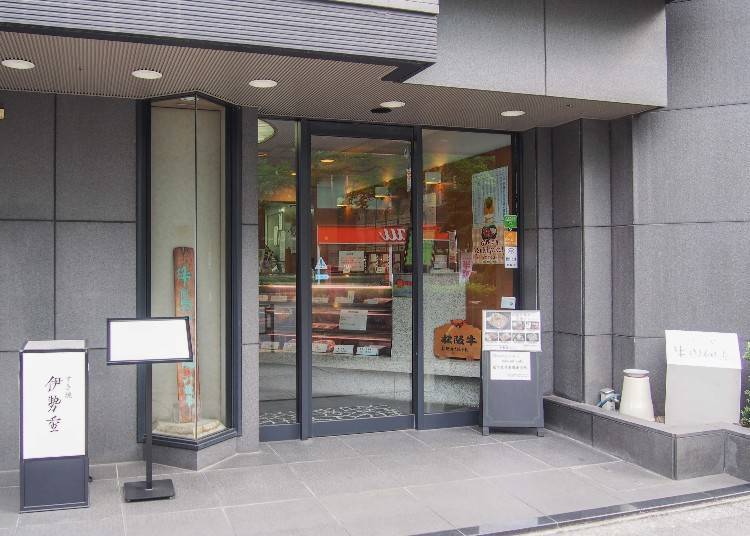
Nihonbashi Iseju was founded in 1869 and thus boasts a legacy of more than 150 years as a wagyu (Japanese beef) specialty store.
It’s located in Nihonbashi’s Kodenmachō neighborhood, and just a 2-minute walk away from Kodemmachō Station – very convenient access!

Nihonbashi Iseju occupies the ground and first basement floor of the building. On the first floor, you can buy fresh meat, take-away delicacies, souvenirs, and so on, while the restaurant area is located on the basement floor.

All seats are Japanese-style private rooms, so look forward to a calm and comfortable atmosphere. Especially the large hall is often used for banquets of tour groups or company events. Of course, even solo diners will find a cozy spot!
Nihonbashi Iseju has two entrances on the first floor. The large glass door on the right leads to the meat counter, while the smaller glass door with the wooden frame connects to the restaurant area.
You will have to take your shoes off if you enter from there, but you can use whichever door you like as the interior is connected.


Nihonbashi Iseju also holds the title of Tokyo’s oldest sukiyaki specialty store. The characteristic of using grade A5 Japanese black beef such as Matsuzaka beef for the savory dishes has been passed down since the Edo period.
Since Nihonbashi Iseju’s very first day, earthen braziers are used for cooking the sukiyaki right at the table.
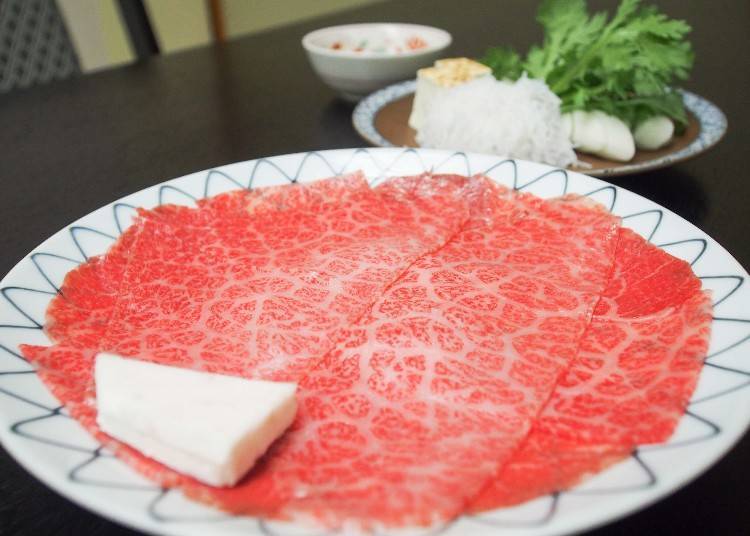
The meat for their signature dish is never cut by machine but by hand with traditional slicing methods. The skilled chefs carefully look at the texture of the beef and cut it accordingly, making it softer and bringing out the umami flavor even more.
Beef cut in that way has an extraordinary melt-in-your-mouth quality and is heavenly tender!

Nihonbashi Iseju’s sukiyaki is prepared Kanto-style. First of all, a small amount of sukiyaki stock that hasn’t changed since the restaurant’s founding is put into a small pot and brought to a boil.

Then, ingredients such as meat, green onions, tofu, konnyaku noodles, and edible chrysanthemum are added one after another as the pot is stewing. If you have any remaining ingredients, you may add them as you please.
The longer the sukiyaki is simmering, the more the rich flavor of the soup stock penetrates the individual ingredients. This is a major reason why eating sukiyaki is such a fun and delectable experience.

We ordered Sukiyaki A Set for lunch (2,900 yen), which features Iseju’s first-class wagyu beef. It comes with both rice and miso soup. Depending on the rank of the beef and the garnishes, you can choose what kind of set menu you’d like.

Lunch Sukiyaki Sets
・A set: Iseju’s Premium Wagyu, Miso Soup, and Rice for 2,900 yen
・B set: Iseju’s Extra Premium Wagyu, Miso Soup, and Rice for 3,900 yen
・C set: Iseju’s Choice Wagyu, Miso Soup, and Rice for 5,000 yen
・S set: Iseju’s Prime Choice Wagyu, Miso Soup, and Rice for 6,000 yen
*All prices are without tax.
*A service fee of 10% will be billed extra.
-
Nihonbashi Iseju日本橋 伊勢重
- Address 14-9 Nihonbashikodenmachō, Chūō-ku, Tōkyō-to 103-0001
- Phone Number 03-3663-7841
Hours
Lunch: 11:00 a.m. – 4:00 p.m.
Dinner: 4:00 p.m. – 10:00 a.m. (last order at 9:30 p.m.)
Closed: Sundays, national holidays
Access: Kodemmachō Station (Tokyo Metro), 2 minutes on foot from Exit 1
*English menu available.
2. Asakusa Sushisei (Est. 1891): Authentic Edomae Sushi Lets You Taste Asakusa’s Traditional Charm!

When we think about eating authentic sushi in Tokyo, many of us imagine tatami-floored restaurants at the Tsukiji Market, richly topped seafood bowls, or casual conveyor belt spots.
However, this time, we change that image a bit and take you to Asakusa, to a sushi restaurant with more than 100 years of history, to be precise! It’s a spot where the vibrant culture of common life in Edo is still living and breathing!

Asakusa Sushisei is a 5-minute walk away from the famous Kaminarimon. Head towards Kaminarimon 1-Chome Intersection, and you’ll see a colorful sign with the kanji すしや通り, meaning “sushi street.”
During the Meiji era, this particular street boasts so many sushi shops and restaurants, that it got this nickname that still sticks to this very day. Of course, most shops have come and gone, but Asakusa Sushisei keeps operating for 130 years and counting.
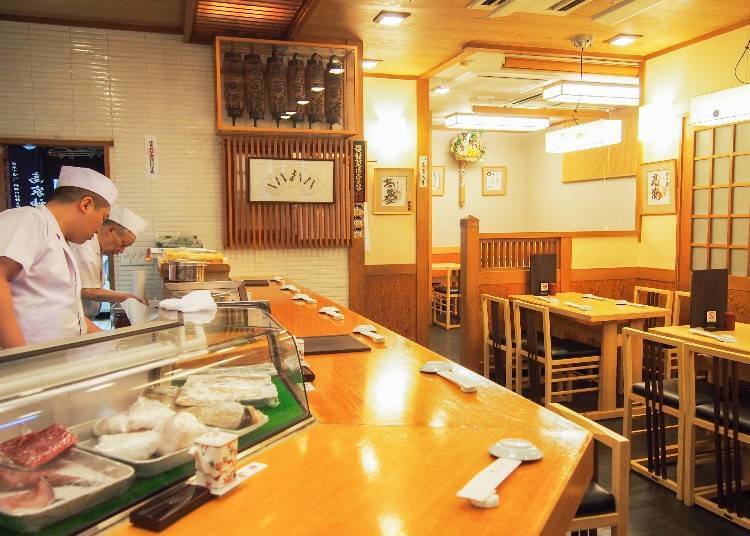
Asakusa Sushisei was founded in 1891 and has specialized in authentic Edomae sushi since then. Everything this restaurant serves comes from the Tsukiji Market, fresh seafood, and produce from Tokyo Bay, Chiba, Hokkaido, Ishikawa, and Shizuoka.
The production area is always written next to each topping, allowing you to savor the wonderfully fresh taste with a bit of extra information.
While Asakusa Sushisei’s sushi is rather high-grade, the cozy and laid-back atmosphere of the restaurant is inviting and welcomes everyone.
It’s a great spot for smaller groups or anniversaries, and especially tourists will have a great time enjoying authentic sushi in a casual setting. However, if you’re curious about the chefs' skills, do choose a counter seat and watch them work their sushi magic.

We asked Asakusa Sushisei’s staff whether they could teach us secrets about how to eat sushi. A lot of international travelers seem to come in and dip the shari (sushi rice) in the soy sauce, but the proper way is to dip the neta (topping).
That’s because the rice will start to fall apart once soaked in soy sauce, and the natural taste of vinegar will be compromised as well.
Many people also dissolve the wasabi in the soy sauce, which greatly changes the taste of the sauce. The sushi chef puts a specific amount of wasabi on each piece of sushi, perfectly matching the topping, so you don’t actually have to add more.
Other than that, there are hardly any specific ways or rules when it comes to eating sushi. The most important thing is to eat slowly and properly, savoring the combination of subtle natural tastes.

We ordered the “nigiri sushi omakase course” for 5,000 yen. It includes appetizers, sushi (9 kinds of nigiri and maki sushi), special chawanmushi (steamed egg custard), a clear soup, and a dessert. The toppings are the recommended seafood of the day and boast a lot of delicious variety, so it’s a great choice for sushi first-timers.

We’re served four different appetizers: whelk, Japanese butterbur simmered in soy sauce, whitefish “nanbanzuke,” and a variety of pickles and other small dishes.
They stimulate the appetite just perfectly. The sushi comes as nine pieces in total. On that day, we had two pieces of freshly net-fished bluefin tuna from Niigata’s Sado on our plate, having a delectable aroma and unrivaled freshness, as well as shrimp from Oita, homemade fried egg with a subtle sweetness, grilled conger eel directly from Tokyo Bay, and firm-to-the-bite blood clam from Yamaguchi.

The soup and chawanmushi also featured plenty of different ingredients – it’s a real feast for the eyes on top of tasting absolutely amazing. Of course, there’s an a la carte menu available next to the various courses, with the price ranging from 300 yen to 1,380 yen.
Otoro is available for 1,300 yen, chutoro for 900 yen, tiger prawn for 800 yen, blood clam for 800 yen, sea urchin for 650 yen, conger eel for 380 yen, horse mackerel for 350 yen, and fried egg for 400 yen (prices for 1 piece of sushi each).
If you want to eat ‘til you drop, the omakase course is a great and reasonably priced choice! Don’t just think of Tsukiji for your sushi adventures but make sure to stop by in Asakusa as well!
*All prices are without tax.
-
Asakusa Sushisei浅草 寿司清
- Address 1 Chome-9-8 Asakusa, Taitō-ku, Tōkyō-to 111-0032
- Phone Number 03-3841-1604
Hours:
Tuesdays to Fridays, days before national holidays: 11:00 a.m. – 2:00 p.m.; 5:00 p.m. – 10:00 p.m. (last order at 9:30 p.m.)
Saturdays, Sundays, national holidays: 11:00 a.m. – 2:00 p.m.; 5:00 p.m. – 9:00 p.m. (last order at 8:30 p.m.)
Closed: Mondays
Access: Tawaramachi Station, 5 minutes on foot from Exit 3
*No multilingual menu available.
3. Torimeshi Torito Bunten (Est. 1907): Tsukiji’s Long-Established “Oyakodon” Restaurant!

While most known for being the former site of Tokyo's tuna auction, Tsukiji Outer Market has a lot more to offer than just seafood. Torito Bunten is a prime example of the area’s gourmet-tastic diversity, as it specializes in fresh chicken and egg dishes!

While the actual auction and wholesale part of the Tsukiji Market was relocated, the Outer Market and its many shops and restaurants stay where they are. Torito is part of that, having been a wholesaler of poultry since 1907.
That business opened Torimeshi Torito Bunten as its restaurant about 10 years ago, serving dishes with wonderfully fresh chicken and eggs, such as its most popular dish called oyakodon (“parent and child bowl”), combining juicy chicken with fresh egg.
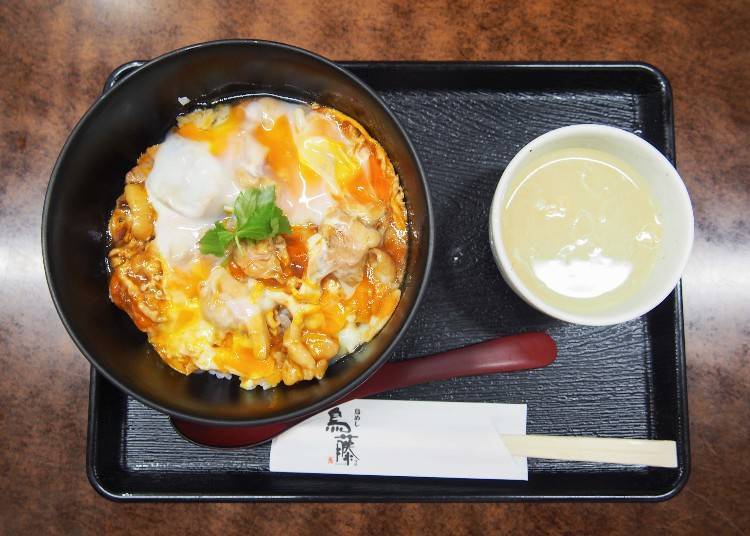
Oyakodon is a delicious bowl that is made by topping rice with chicken, egg, and onions. Needless to say, it gets its name of “parent and child bowl” from that very combination.
Making oyakodon is not hard, so the most important factor is how good the ingredients are. The chicken should be tender and juicy; the egg should be soft and flavorful.
Of course, this restaurant uses its ingredients directly from the wholesale business of Torito, so look forward to poultry from all around Japan slaughtered the very same day it is served. You can’t go fresher than that! As we ate at Torito Bunten, our chicken came from Iwate Prefecture.

As a poultry wholesaler, Torito Bunten screens and processes the chicken in a strict, professional manner. With low heat, the bowl becomes especially mellow, and with a wonderfully creamy mouthfeel, the semi-soft egg and the juicy chicken will have you close your eyes and hum in delight. It’s so popular that about 100 bowls a day are sold!
This delicious bowl is also served with a chicken soup that has been stewed for a full day, infused with chicken extract and boasting a rich, deep flavor.
This soup is also used for the oyakodon itself, so if you’re a fan of chicken or poultry in general, this restaurant is an absolute must-try! So the next time you’re in Tsukiji, make sure to stop by!
*All prices include tax.
-
Torimeshi Torito Bunten鳥めし 鳥藤分店
- Address 4 Chome-8-6 Tsukiji, Chūō-ku, Tōkyō-to 104-0045
- Phone Number 03-3543-6525
Hours: 7:30 a.m. – 2:00 p.m.
Closed: Wednesdays (irregularly), Sundays, national holidays
Access: Tsukiji Station (Tokyo Metro), 3 minutes on foot from Exit 1
*English and Chinese menu available.
*Cash only.
4. Izuei Honten: Serving Unagi Eel Bowls in Ueno for Over 300 Years!

Ueno is a popular sightseeing area of Tokyo, featuring the famous shopping street of Ameyoko, Ueno Zoo and its lovely pandas, and Ueno Park’s stunning cherry blossoms!
Back in the day, Ueno was a bustling downtown area of Old Edo, so you’ll also still find a lot of long-established shops and restaurants here. Izuei Honten is one of them, focusing on savory unagi (eel) delicacies.
Said to recharge your energies and beat the summer heat, eel has been a well-beloved dish in all of Japan and is a great choice to have during a busy day of sightseeing!
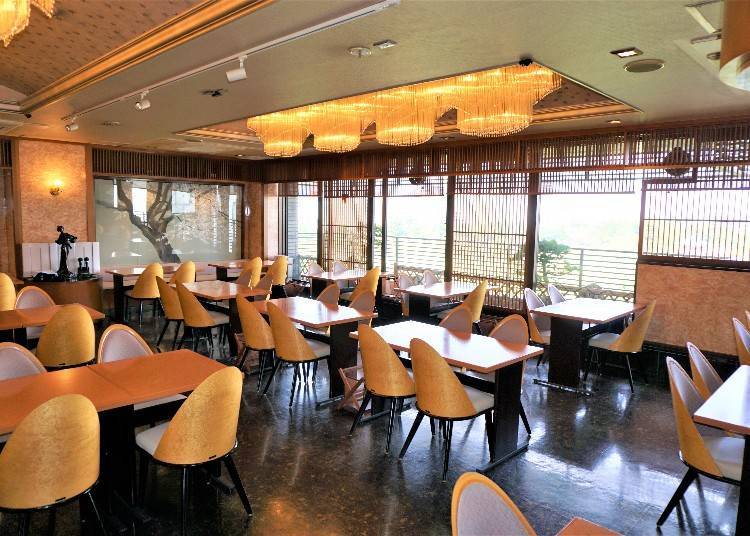
Izuei was established in the middle of the Edo period, around the time of the 8th shogun of the Tokugawa family – that means a history of about 300 years!
Starting as a small store specializing on eel, Izuei Honten (“main store”) has grown into a 7-story restaurant. It also has branches called Umekawa-tei, Shinobazu-tei, and Nagata-cho.

Traditionally, eel is served grilled and coated with a special sauce as a topping on white rice. It’s especially eaten a lot during summer, said to recharge one’s energies and give strength and vitality.
The three major components of unagi are eel, sauce, and rice. Izuei uses a brand eel called mikawa manzaku from Aichi Prefecture’s Mikawa Isshiki area. That eel grew up in the mineral-rich, natural water of the Yahagi River, so you know you’re in for a real treat!
The sauce used for the grilling does not include any extra sugar, solely made from mirin and soy sauce.
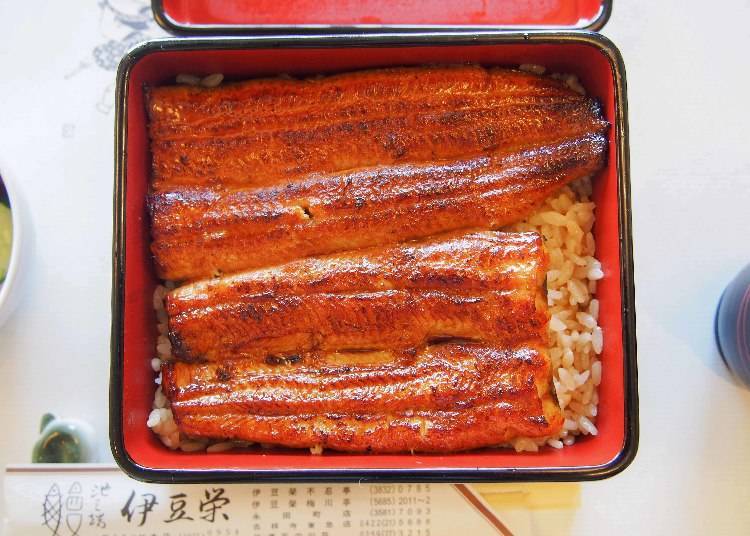
To make delicious unagi, you basically have to follow three steps: cutting the eel, skewering it, and then grilling it. However, all of these steps require a professional routine, and especially the “grilling” part is where the flavor lies.
Izuei follows the traditional Edo way of preparing eel and cuts the fish open from the back. Cutting the eel open from the belly side is called seppuku and should be avoided!
Then, it is coated in sauce three times with a soft brush and grilled over a charcoal fire, while the temperature is closely monitored and reduced. These traditional grilling methods of the skilled chefs make for a heavenly delicious eel that’s a gourmet experience like no other.

We ordered the “Unaju Bamboo (“special”)” for 4,320 yen and got a premium taste with a delicate sweetness engulfing the flavorful grilled eel. The traditional taste of Izuei has a lot of fans, particularly families and seniors who seem to enjoy it very much.
It’s a gourmet experience that Japanese summer is famous for, but the delicious flakiness of grilled eel can – and should – be savored in any season! Give it a try!
*All prices include tax.
-
 Has Health & Safety Measures
Has Health & Safety Measures-
Address
2-12-22, Ueno, Taito-ku, Tokyo, 110-0005
View Map -
Nearest Station
Keisei Ueno Station (Keisei Main Line / Narita SKY ACCESS Line)
- Phone Number 03-3831-0954
-
Address
2-12-22, Ueno, Taito-ku, Tokyo, 110-0005
5. Yoshoku Kurofune-tei: Savoring 100-Year Old Traditional Deliciousness of Western-Inspired Japanese Food!

Yoshoku Kurofune-tei is a famous restaurant near Ueno Park and Ameyoko, which has been in business for over 100 years.
It started as an eatery called Torinabe before it was turned into a curry shop, a Chinese restaurant, and a French restaurant, until becoming the Kurofune-tei of today in 1986. It has inherited both the spirit and the traditional techniques of old, with chefs trained in French cuisine serving delicious Western-style Japanese food.


Kurofune-tei boasts a whole variety of popular dishes, and we tried the beef stew for 3,300 yen that features beef, onions, potatoes, and more.
The demi-glace sauce, which can be called the soul of Western-style Japanese cuisine, is used for this stew, giving all the ingredients a rich and savory umami flavor. The recipe for this sauce has been handed down since the very beginning and is both the restaurant's pride and essence.

Kurofune-tei’s demi-glace sauce is always made the same way: all sorts of select ingredients are put in a pot and simmered at low temperatures.
Then, more ingredients are added and simmered again. This process is repeated for a week, getting finer each time until it becomes the rich demi-glace sauce for this beef stew.
While it is rich in taste, it is only moderately salty and thus not heavy on the stomach at all, having only a slight note of sourness and instead letting the taste of the ingredients shine through.
The meat for the stew is wagyu beef which has been left to simmer for about one and a half hours. It has a nice balance between lean and fatty meat, and even large chunks are wonderfully tender!
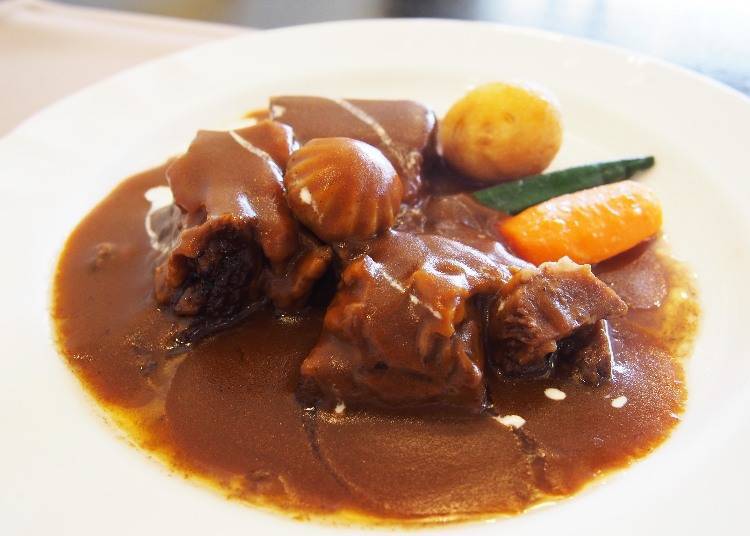
We also recommend the Hayashi Rice for 1,700 yen, using the same demi-glace sauce. With a hint of red wine, the taste is slightly different than the other dishes on the menu and perfect for a sophisticated palate.
The umami flavor of the meat and vegetables are brought out nicely by the demi-glace sauce stewed for one week, tickling your taste buds with a subtle sweet-and-sour note.
Another popular choice is the omelet rice with chicken and shrimp for 1,450 yen, but really, any of the dishes are classic examples of Western-style Japanese cuisine and worth a try. Kurofune-tei sees about 150 to 200 guests on weekdays and even more during holidays.

Kurofune-tei’s menu boasts another characteristic. Every dish is created to match white rice perfectly, further blending the unique tastes of Western and Japanese cuisine.
This is something that the restaurant is particularly proud of. On top of that, all ingredients are domestically produced, so this gourmet experience is healthy safe for everyone, from children to elders. That’s why Kurofune-tei is a popular choice among families and older Japanese people.
So while you might know your way around Western-style cuisine, go ahead and try Japan’s delectable take on it!
*All prices are without tax.
Whether it is traditional sukiyaki or another Japanese-style food, there are exclusive ancestral recipes and persistences in each store - passed down over four or more generations. Be sure to drop by at least one of these treasures during your Japan stay!
*The above information is as of June 2018.
*Product prices and information are subject to change.
- Area
- Category
*Prices and options mentioned are subject to change.
*Unless stated otherwise, all prices include tax.
Popular Tours & Activitiess
Recommended places for you
-

A Travel Game Changer! Go Hands-Free Between Tokyo and Kyoto with LUGGAGE EXPRESS by JTB and JR Tokai
by: Guest Contributor
-

Tokyo City Pass Upgrade: Harry Potter Studio Tour & Top Sights up to 85% Off
by: Guest Contributor
-

The Best Japanese Food Representing 2025! 'Dish of the Year®' Annual Award Results Announced
-

New Seibu L00 Series Launching in 2026! What to See Along the Tokyo-Area Golden Route
by: Guest Contributor
-

Strawberries, Style, and Tokyo’s Coolest Neighborhood: Winter Afternoon Tea in Kichijoji
by: Guest Contributor
-
Ad

Preserving the Beauty of World Heritage Site Shirakawa-go for the Future Through Responsible Travel
Inspiration for Accommodations
-

Enjoy Mt. Fuji from the Comfort of Your Room! Recommended Ryokan with Mt. Fuji View
-

Stay Near the Cherry Blossoms! Hotels for Cherry Blossom Viewing in Tokyo
-

Family-Friendly Hotels with Free Shuttle to Disneyland: Convenient Access for a Magical Stay
-

Top Ranked Hakone Hotels with Mt. Fuji View: Enjoy Stunning Scenery from Your Private Space
-

Convenient Tokyo Hotels with Airport Shuttle: Ideal for Families and Heavy Luggage
-

Stunning Tokyo Tower View Hotels: Enjoy Spectacular Scenery from Your Private Space
-

Convenient Asakusa Hotels with Kitchens: Ideal for Extended Family Visits
-

Experience Luxury: Hakone's 10 Best Five-Star Accommodations
-

Enjoy Mt. Fuji Autumn Leaves! Top Hotels Near the Popular Autumn Leaves Corridor
-

Experience Hakone Fall Foliage from Your Room with Stunning Views
-

Wagyu Sukiyaki in Ueno Tokyo: Get Your Fill of Japanese Beef in Ameyoko!
-

Healthcare in Japan for Tourists: What to Do When You Get Sick or Injured in Japan
-

16 Secrets About Mt. Fuji, the Symbol of Japan: Even Japanese People Don’t Know That?!
-

Top 4 Places for Lunch in Shinjuku: Beefsteak, Bibimbap, Sukiyaki, and Roast Beef Bowl from just 500 yen!
-

Marvel at the Marbling! 142-Year-Old Sukiyaki Restaurant 'Chinya' in Asakusa Reopens
by: Miyu Shimada
-

6 Fun Things to Do at Tokyo's World-Famous Tsukiji Outer Market!
- #best ramen tokyo
- #what to buy in ameyoko
- #what to bring to japan
- #new years in tokyo
- #best izakaya shinjuku
- #things to do tokyo
- #japanese nail trends
- #what to do in odaiba
- #onsen tattoo friendly tokyo
- #daiso
- #best sushi ginza
- #japanese convenience store snacks
- #best yakiniku shibuya
- #japanese fashion culture
- #best japanese soft drinks



















